New England Patriots' Defense: Change In The Past And For The Future
Going into this season, the New England Patriots' defense looked like one of the NFL's best. The additions of Darrelle Revis and Brandon Browner, along with getting guys like Jerod Mayo and Vince Wilfork back from injury, made this defense one of the most talented on paper.
But after being run on for 191 yards in a 33-20 week one loss against the Miami Dolphins, New England's defense, especially defending the run, looked like a mess. Miami's offensive line looked dominant, and the running back tandem made up of Knowson Moreno and Lamar Miller were made to look like one of the best in the NFL.
After turning on the tape, a big reason for the Patriots' poor performance wasn't necessarily a lack of talent, but rather poor coaching and occasionally bad gap discipline by some of their more inexperienced players (ahem, Jamie Collins).
The most important thing to note from this game on the Patriots' side is how Chandler Jones was used. Jones is 6'5" and 265 pounds, which is almost a prototypical size for a 4-3 defensive end or a 3-4 outside linebacker (for reference, DeMarcus Ware is 6'4" and 260 pounds). Jones also has exceptionally long arms that he uses very well. Similar to a player like Aldon Smith, Jones uses his hands and long arms to beat offensive linemen rather than pure speed and athleticism.
While Jones' relatively slight build seemingly casts him as an edge rusher/defender, Bill Belichick played him on the interior of the defensive line for the majority of week one. This didn't go too well.
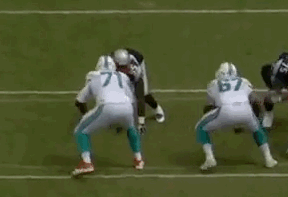
Here, for instance, Jones (#95) lines up at 4-technique head-up on the left tackle. The Dolphins run right at him, and as you can see, it does not go well. Jones handles the double team poorly and get obliterated off the snap. Jones comes off the snap high, enabling the offensive linemen to get underneath his pads and drive him out of his lane. Better, more experienced players in this situation would stay low and anchor against the double team, theoretically blocking off the running lane and allowing his fellow defenders to chase down the running back from the back side. Jones begins the play lined up in a position where he is expected to defend the run first and foremost, rather than rush the passer.
There were also multiple instances in this game where Jones was expected to "two gap," or control the gaps to either side of the offensive lineman he was across from. This is an extremely difficult job that only some of the best run defenders in the NFL can do, and it's no easy task for a 265-pound player going up against linemen who outweigh him by 50 or 60 pounds. The results were predictable--Jones was often washed out of the play, and even when he was able to hold his ground, he wasn't always strong enough to disengage and make the arm tackle on the ball carrier. This is no fault of Jones, as players of his physical build shouldn't be expected to consistently hold up to that kind of technique.
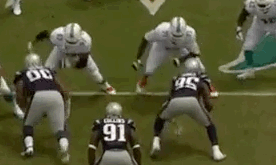
Instead, as shown here, Jones is far better in a single-gap role where he is asked to get around offensive linemen as opposed to going through them. Jones uses his quickness to shoot the gap between the tackle and the tight end, and even ends up helping to make the tackle.
Another thing I noticed from the Patriots' personnel use against the Dolphins was the deployment of rookie first round pick Dominique Easley. Easley is well-known for being an athletic freak who theoretically fits best in a pass rushing role where he would be able to shoot gaps in between offensive linemen and get upfield.
However, I was rather disappointed by the way he was used in week one, often playing as a 3-4 defensive end in a 5-technique role, instead of as a 3-technique in a 4-3 matched up one-on-one with a guard where he would seem to be a better fit. Here's what I'm talking about:
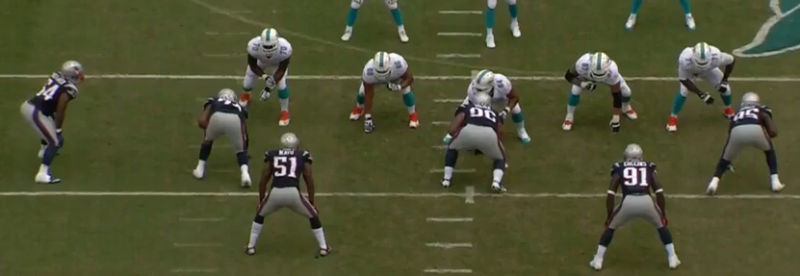
Easley (#74, left defensive end) is lined up as a 5-technique on the outside shoulder of the right tackle here. This position leaves him more susceptible to double-teams, and also matches him against a more athletic offensive tackle rather than a less-athletic offensive guard. Additionally, run responsibilites of a base 3-4 end on early downs are important, and since Easley is obviously a young player who needs time to develop his technique and get stronger, I'm not sure how much I'd trust him in this role. Instead, in an ideal world you'd like to see Easley come in on passing downs as a 3-technique in sub packages where he can make best use of his athleticism.

Here is an even better example of miscast Patriots defenders. Jones, Easley and Rob Ninkovich (#50) are three of New England's best pass rushers. On a passing down such as this, you'd like to see your best rushers have some space to work with in order to use their abilities to the fullest. Instead, Easley is lined up at 0 technique right over center where he is easily double-teamed, Jones lines up at 5 technique and gets chipped inside by the tight end, and Ninkovich crashes inside and gets double-teamed. Those are three guys who should be playing in space, guys who Belichick should scheme to get in one-on-one matchups to take advantage of their skills. Instead, they are easily neutralized from the start in part because of where they line up. There aren't even any stunts to try and free up any of the rushers--very disappointing scheming here.
However, Belichick did something in week two against Minnesota that showed how good of a coach and football mind he really is: he adapted. There are many times when coaches don't want to admit they're wrong about something--a draft pick, a trade, a miscast player--and won't change out of their own pride. But Belichick showed his open-mindedness when he changed up the look of his defensive front against the Minnesota Vikings.
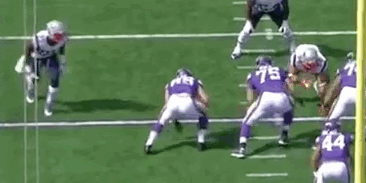
From the very start of the game, Belichick put Chandler Jones on the edge, with more room to work and take advantage of his athleticism. This was one of the first plays, and Jones showed his ability against the run as an edge defender right off the bat. The Vikings leave him unblocked, counting on the fact that he wouldn't be quick enough to crash down on the running back, but Jones makes them pay here.
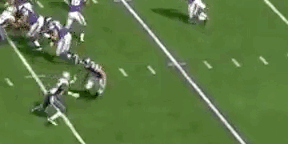
Jones again showcases his run defense skills on the edge as he defeats the tight end and stuffs Jarius Wright in the backfield on the attempted reverse. It's amazing how good Jones looks when he's not fighting off double teams as a 265 pound defensive tackle!

Jones didn't just handle tight ends--he consistently beat left tackle Matt Kalil (one of the better left tackles in the NFL) in the pass game as well. This is just one example of many I could have shown of Jones winning off the edge against Kalil. Again--Jones playing on the edger>Jones playing on the interior. Jones doesn't have the strength to consistently win inside against guards and double teams, but he does have the hand moves and speed to win off the edge against tackles.
Now, that's not to say Jones should only play on the edge--I actually think he can be a pretty good interior rusher on passing downs:
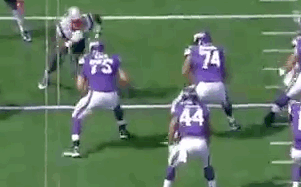
His arm length, hand use and quickness allows him to create space for himself and handle the guard here on his way to a hit on Matt Cassel. On passing downs when his priority is getting after the quarterback, Jones could definitely be kicked inside as an interior rusher.
Another problem in this game I briefly touched on earlier was Jamie Collins. In my piece here, you can see what I think of him from an ability standpoint, but as seen from week one, he still has a ways to go.
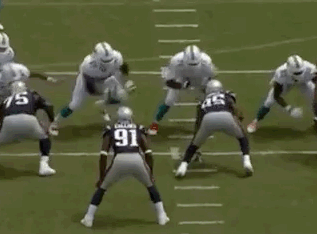
Here, Collins (#91) tries to get around the guard at the second level instead of engaging the guard and shedding him. This results in Collins losing his gap, and a large run ensues. As a 3-4 middle linebacker with only three defensive linemen in front of him to take up blocks, Collins will see a ton of these kinds of plays every game, and he'll have to get used to (and be better at) taking on bigger, stronger offensive linemen at the second level.
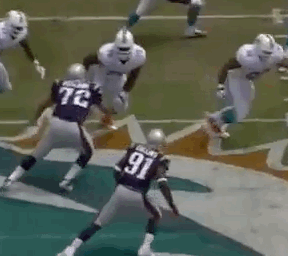
A similar play happens here later, and Collins tries to shoot his gap to get to the running back, but over-pursues and takes himself out of the play instead. He essentially does the offensive lineman's job for him here.
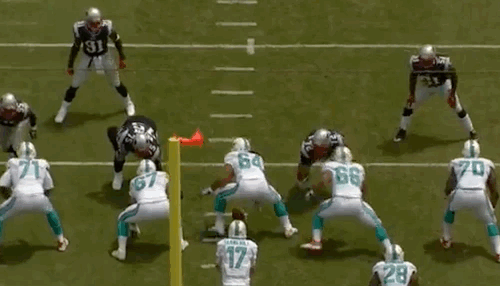
Here, however, the Patriots line up in a 4-3 style defense with a 1 technique and a 3 technique. This change in defensive alignment makes Collins' job easier, since now he has less defensive traffic to work through. As you can see, Collins easily diagnoses the play and has a clear lane in which to make a play on the ball carrier. At this point in Collins' career, I think putting him in space like this where he can take full advantage of his athleticism is the best way to use him.
So what does all of this mean? Belichick did a much better job using Jones in week two, but it still wasn't perfect. For instance, he had Jones doing this on a number of occasions:

Having your best pass rusher essentially throw any chance of getting to the quarterback out the window just so he can jam the tight end doesn't seem like the best idea.
Still, Jones' use in week two overall was much better than in week one.
Honestly, I think the personnel of the Patriots' defense is better suited for a 4-3 scheme instead of the 3-4 they largely play now.
Jones is clearly a fantastic edge player, and would be a great 4-3 defensive end. Collins is an elite athlete, and I believe would greatly benefit from playing weakside linebacker in a 4-3 where he could play coverage and attack in space.
Dont'a Hightower, who I have neglected to mention up to this point, played a lot of 3-4 outside linebacker over the last two weeks, but looks uncomfortable--he doesn't possess much burst off the line of scrimmage, he isn't that polished with his hands yet, and doesn't seem to have the ideal length for a pass rusher. He has only stood out to me in a positive way a couple times, and looked lost playing in space in the run game against Miami especially--he was asked to sit back and react to the offensive players (i.e. reacting to the zone read option) instead of attacking downhill and making the offensive players react to him. He's a big guy, listed at 270 pounds, who is probably better suited as a downhill linebacker in a 4-3. I think he would be a better fit as a strongside 4-3 linebacker where he can use his strength and size to take on blocks and make tackles in the run game while also being able to drop into coverage where he can use his surprising athleticism in spite of his size. And if Belichick wants to develop him as a rotational rusher in sub packages, so be it.
I also think Vince Wilfork--largely seen as a prototypical 3-4 nose tackle--would do just fine playing as the 1-technique in a 4-3 where he'd consistently take on double teams, and as I previously mentioned, Easley is a natural fit is at 3-technique. With Ninkovich at the other defensive end spot opposite Jones, that's a pretty nice front seven (plug in Jerod Mayo at middle linebacker) that plays to the strengths of most of its players.
I also forgot to mention a player probably most of you haven't heard of--Sealver Siliga. While Siliga won't give much in terms of pass rush, he excels in run defense, and has done so over the past couple seasons.
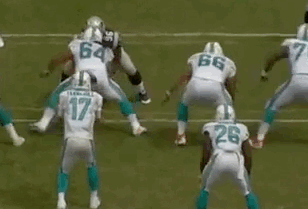
Watch him here as he "two-gaps" on either side of the left guard, disengages, and then makes the tackle.
Siliga is a nice rotational piece for the interior of the line, and not much would be lost replacing Wilfork with Siliga for a few snaps here and there. Also, the Patriots could play him at 4 technique or 5 technique in a base 4-3 defense for a little extra beef to help stop the run, much as the Seattle Seahawks did with Red Bryant when he was in their starting lineup in years past.
The Patriots' defense improved mightily from week one to week two, which is definitely encouraging and a sign of good coaching. As a fan who just wants to see good football, I hope this upward trend continues. New England already has one of the more talented secondaries in the league, and Brandon Browner hasn't even been on the field yet--with better play out of their front seven, the Patriots' defense could be the best in the league.
Reach Staff Reporter Andrew McKagan via e-mail here and on Twitter here.



